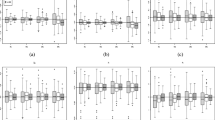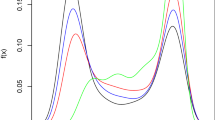Abstract
The determination of an appropriate distribution for concentration data is of major importance in chemical risk assessment. The selection and the estimation of an appropriate distribution is hindered by observations below the limit-of-detection and the limit-of-quantification, leading to left-censored and interval-censored data. The log-normal distribution is a typical choice, owing its popularity from the use of the log transform in daily laboratory practice, in combination with the nice mathematical and computational properties of the normal distribution. But the log-normal should not be the only choice and other distributions need to be considered as well. Here we focus on several families of distributions that are related to the log-normal distribution in some direct or indirect way, and that are parametric or semi-nonparametric extensions of the log-normal distribution: the log-skew-normal, the log-t, the log-skew-t, the Weibull, the gamma, the generalized-gamma, and the semi-nonparametric estimator of Zhang and Davidian (Biometrics 64(2):567–669, 2008). Whereas Nysen et al. (Stat Med 31:2374–2385, 2012) developed methodology to test the goodness-of-fit of a particular hypothesized distribution, our interest here goes to model selection and model averaging, using all parametric models only or in addition the series of extensions of the log-normal underlying the semi-nonparametric estimator. The models and methods of selection and averaging are further investigated through simulations and illustrated on data of cadmium concentration in food products.



Similar content being viewed by others
References
Aerts M, Claeskens G, Hart J (1999) Testing the fit of a parametric function. J Am Stat Assoc 94(447):869–879
Akaike H (1973) Information theory and an extension of the maximum likelihood principle. In: Petrov B, Csaki F (eds) 2nd International symposium on information theory, Akademiai Kiado, Budapest (Reproduced in Breakthroughs in Statistics, vol 1 (eds. S. Kotz and N. L. Johnson), Springer, New York (1992), pp 267–281
Azzalini A, Dalla Valle A (1996) The multivariate skew-normal distribution. Biometrika 83(4):715–726
Azzalini A, Dal Cappello T (2003) Log-skew-normal and log-skew-t distributions as model for family income data. J Income Distrib 11:12–20
Burnham K, Anderson D (1998) Model selection and inference: a practical information-theoretical approach. Springer, New York
Burnham K, Anderson D, Huyvaert K (2011) AIC model selection and multimodel inference in behavioral ecology: some background, observations, and comparisons. Behav Ecol Sociobiol 65:23–35
Claeskens G, Carroll R (2007) An asymptotic theory for model selection inference in general semiparametric problems. Biometrika 94:249–265
Claeskens G, Hjort N (2003) The focused information criterion. J Am Stat Assoc 98(464):900–916
Claeskens G, Hjort N (2008) Model selecting and model averaging. Cambridge University Press, Cambridge
Davison A (2003) Statistical models. Cambridge University Press, Cambridge
EFSA (2010) Management of left-censored data in dietary exposure assessment of chemical substances. EFSA J 8(3):96
Faes C, Aerts M, Geys H, Molenberghs G (2007) Model averaging using fractional polynomials to estimate a safe level of exposure. Risk Anal 27:111–123
Fenton V, Gallant A (1996) Qualitative and asymptotic performance of snp density estimators. J Econ 74:77–118
Gallant A, Nychka D (1987) Semi-nonparametric maximum likelihood estimation. Econometrica 55(2):363–390
Hart J (1997) Nonparametric smoothing and lack-of-fit tests. Springer, New York
Hewett P, Ganser G (2007) A comparison of several methods for analyzing censored data. Ann Occupat Hyg 51(7):611–632
Hurvich C, Simonoff J, Tsai CL (1998) Smoothing parameter selection in nonparametric regression using an improved akaike information criterion. J R Stat Soc B 60:271–293
Kaplan EL, Meier P (1958) Nonparametric estimation from incomplete observations. J Am Stat Assoc 53:457–481
Lin G, Stoyanov J (2009) The logarithmic skew-normal distributions are moment-indeterminate. J Appl Probab 46:909–916
Moy G (2013) Total diet studies. Springer, New York
Namata H, Aerts M, Faes C, Teunis P (2008) Model averaging in microbial risk assessment using fractional polynomials. Risk Anal 28:891–905
Nysen R (2015) Statistical methodology for left- and interval-censored analytical data in environmental risk assessment. PhD thesis, Hasselt University, Belgium, URL http://ibiostat.be/publications
Nysen R, Aerts M, Faes C (2012) Testing goodness of fit of parametric models for censored data. Stat Med 31:2374–2385
Schmoyer R, Beauchamp J, Brandt C, Hoffman F Jr (1996) Difficulties with the lognormal model in mean estimation and testing. Environ Ecol Stat 3:81–97
Schwarz G (1978) Estimating the dimension of a model. Ann Stat 6(2):461–464
Stacy E (1962) A generalization of the gamma distribution. Ann Math Stat 33(3):1187–1192
Symonds R, Matthew Moussalli A (2011) A brief guide to model selection, multimodel inference and model averaging in behavioural ecology using akaike’s information criterion. Behav Ecol Sociobiol 65:13–21
Zhang M, Davidian M (2008) “Smooth” semiparametric regression analysis for arbitrarily censored time-to-event data. Biometrics 64(2):567–669
Acknowledgments
This research was supported by the IAP research network nr P6/03 of the Belgian Government (Belgian Science Policy). For the simulations we used the infrastructure of the VSC - Flemish Supercomputer Center, funded by the Hercules Foundation and the Flemish Government - department EWI. The authors thank the members of the EFSA Working Group on Left Censored Data (Martine Bakker, Peter Fürst, Gerhard Heinemeyer, Jessica Tressou, Philippe Verger and the EFSA staff members Pietro Ferrari, Olaf Mosbach-Schulz, Billy Amzal) and are grateful to EFSA for the approval to use the cadmium data (EFSA/DATEX/2007/005). The authors thank the reviewers for their suggestions and constructive comments, which helped us to improve the manuscript.
Author information
Authors and Affiliations
Corresponding author
Additional information
Handling Editor: Pierre Dutilleul.
Rights and permissions
About this article
Cite this article
Nysen, R., Faes, C., Ferrari, P. et al. Parametric and semi-nonparametric model strategies for the estimation of distributions of chemical contaminant data. Environ Ecol Stat 22, 423–444 (2015). https://doi.org/10.1007/s10651-014-0304-5
Received:
Revised:
Published:
Issue Date:
DOI: https://doi.org/10.1007/s10651-014-0304-5




